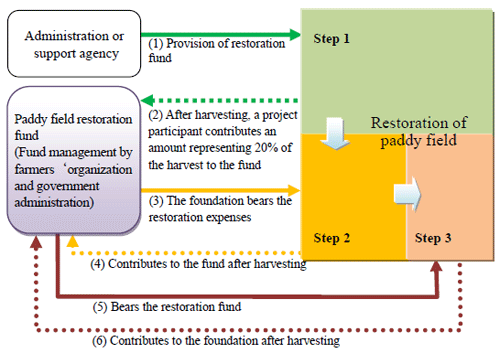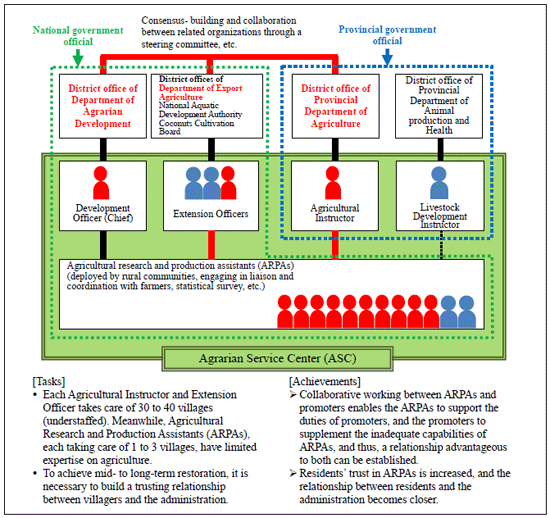Demonstration of the Rural Reconstruction Method in Sri Lanka and development of the Guidelines
Description
The Indian Ocean Tsunami, which occurred in December 2004, also caused extensive damages to Sri Lanka. Although the restoration of living infrastructures and public facilities has progressed, the restoration of agricultural production infrastructures such as paddy fields and irrigation and drainage facilities has not progressed as much. This is because these damages are not easily recognized, and factors that prevent restoration such as too much dependence of farmers are complexly inter-related. Therefore, this guideline puts together the results of the study on methods for facilitating the restoration of agricultural production infrastructure while utilizing farmer organizations, and of verifying an agricultural support system utilizing local administrative officials, as well as lessons learned, in the local language (Sinhalese).
A method for continuous paddy field restoration by implementing restoration activities of paddy fields left untreated after the tsunami disaster, by contributing part of the earnings from rice production at restored paddy fields to a paddy field restoration foundation, and advancing the paddy field restoration work using the foundation has been proposed in the guideline (Fig. 1). The result of the demonstration of the method performed in Thalalla South Village indicates that paddy fields of 8.3 ha were restored first, then a second paddy field restoration work was performed using the acquired funding, and thus paddy fields of up to 3.0 ha were further restored. The yields have been recovered up to 2.7 t/ha, which accounts for 70% of the provincial average, from no yield at all in the past years. In Sri Lanka, many paddy fields have been left untreated and are covered in weeds after being damaged by floods or the like aside from being due to the tsunami disaster. If the administration or support agencies could use this method, it would be possible to effectively restore these farmlands with a limited budget while increasing the independence of farmer organizations.
An Agrarian Service Center has functions from which one-stop administrative services related to agricultural and rural areas are expected. However, collaboration between each sector in the center is insufficient, and comprehensive support for residents has not been provided. In addition, only one agricultural instructor is deployed to take care of 30 to 40 villages in one or two divisions, which means that human resources for supporting the residents are insufficient (Fig. 2).
Therefore, this guideline presents a system in which agricultural research and production assistants (ARPAs) are trained as facilitators, and they can engage in supporting the reconstruction of agricultural and rural areas in cooperation with other officers, while showing an example by demonstrating through a small-scale gardening activity. Utilizing this system would raise the awareness of ARPAs and the residents’ feeling of trust, and enable the provision of generous support to the residents.
Figure, table
-
Fig. 1. Diagram of the paddy field restoration project utilizing the paddy field restoration fund -
Fig. 2. New collaboration within the Agrarian Service Center.
- Affiliation
-
Japan International Research Center for Agricultural Sciences Rural Development Planning Division
- Classification
-
Technical
- Term of research
-
FY2006~2010
- Responsible researcher
-
HIGASHIMAKI Takeru ( Rural Development Planning Division )
TAKENAKA Koichi ( Rural Development Planning Division )
KODA Kazuhisa ( Rural Development Planning Division )
SHIRAKI Shutaro ( Rural Development Planning Division )
- ほか
- Publication, etc.
-
- Japanese PDF
-
2010_seikajouhou_A4_ja_Part6.pdf228.55 KB


